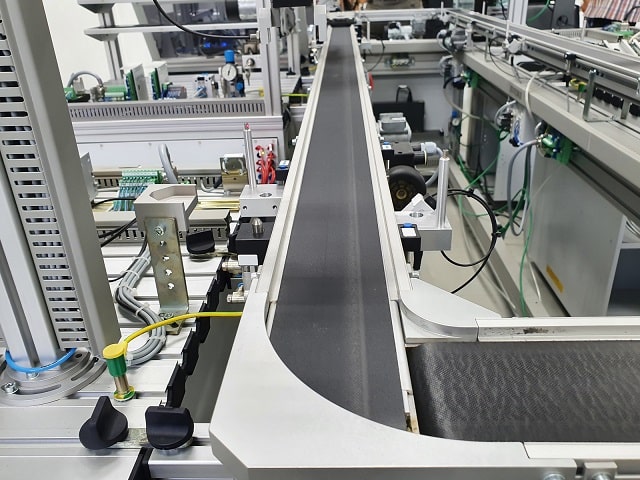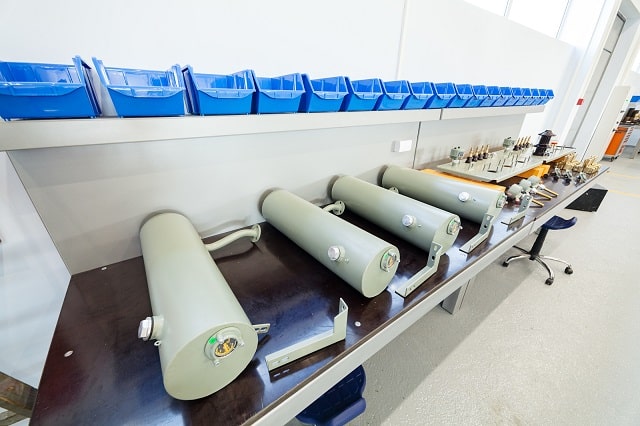Original Equipment Manufacturers (OEMs) are responsible for labeling equipment in a way that supports safe product operation. In many aspects, a labeling program is an extension of other corporate practices such as safety management, quality assurance, and product development. When done properly, product labeling is a beneficial practice that adds value beyond traditional instruction manuals and other forms of equipment documentation. Equipment labels provide valuable details to operators at the point of use and, in some cases, might be the most accessible source of information at a given time.
In addition to cosmetic and branding purposes, equipment labels also support regulatory and quality functions in several important ways. In this guide, we are going to explore important factors for manufacturers to consider when labeling equipment intended for commercial applications. Many requirements should be reviewed including regulatory needs, hazard communication, and environmental compatibility. Ultimately, each manufacturer must design a marking and labeling system that works best for the company’s needs while also meeting regulatory requirements and consumer expectations. Labels can be used for many purposes and the design should be carefully planned for each product prior to launch. As you’ll find in this guide, paying attention to details and establishing a routine review process will make labeling practices easier to implement and control.
Included in this guide:

Equipment manufacturers must manage regulatory requirements from several different sources. Each industry is governed by unique requirements that help maintain a safe work environment for employees and an acceptable level of product performance for consumers. Labeling requirements are also covered by many regulations, and it can be helpful to review some of the basic requirements that apply to major industries.
Food and Beverage. The main governing body that oversees food and beverage equipment manufacturing is the Food and Drug Administration (FDA). Equipment labeling must be carried out in a structured way that adheres to accepted Good Manufacturing Practices (GMP) and Good Laboratory Practices (GLP). Labels can be applied to equipment for the purposes of product identification, Quality Assurance (QA), and packaging. The United States has some of the best food safety practices in the world and has taken major strides since the introduction of the Food Safety Modernization Act (FSMA). A large portion of the FSMA is dedicated to sanitation practices and the creation of strong quality practices. When defining your labeling practices as a food equipment manufacturer it is important to review these guidelines and also consult additional regulatory resources.
Military and Defense. The defense industry is also highly regulated, and the U.S. Department of Defense (DoD) uses the Unique Identification (UID) program to monitor sensitive equipment. Manufacturers must comply with these standards and properly label military equipment that falls within the scope defined by the program. The military document MIL-STD-130, Identification Marking of U.S. Military Property, is the most relevant standard for reviewing UID labeling requirements. Important guidelines include the definition of a UID-controlled asset, how to design a UID label, and important label specifications and compatibility requirements that should be considered.
Medical Devices. The healthcare industry is a highly regulated area, with particular attention placed on medical devices. A medical device is used to treat or diagnose an illness and manufacturers must ensure that this equipment operates as intended and does not pose any unnecessary risks to patient safety. The FDA defines medical device labeling requirements in guidance document FDA 89-4203. This publication provides basic definitions for label creation, placement, and readability. Since 2016, the FDA has also required certain medical devices to be labeled using Unique Identification (UDI) standards including an entry in a Global Unique Device Identification Database (GUDID). This system operates in a similar fashion to the previous program launched and operated by the U.S. DoD for defense equipment tracking.
Other Regulatory Resources. In addition to industry-specific resources, there are also other great regulatory bodies that can be consulted to learn more about equipment labeling best practices. This includes UL, the American National Standards Institute (ANSI), the National Institute of Standards and Technology (NIST), the Federal Communications Commission (FCC), and the Federal Aviation Administration (FAA). This is just a short list of the many governing bodies that share regulations and guidance materials for equipment manufacturers and other supply chain partners. As a detailed example, this list of labeling FAQs from NIST shares some excellent resources including The Fair Packaging and Labeling Act (FPLA) that define general packaging and labeling requirements in the United States.

When choosing equipment labels, it is important to first define the specific applications for which each product will be used. The performance and durability requirements for each application may differ and impact the selection of label substrate, design, and attachment method. Some common equipment label applications include:
In some cases, multiple applications can be addressed by a single label while in other situations multiple tags will be required. As an equipment manufacturer, your label selections are a critical activity that can either improve upon or detract from the product safety and asset management needs of your customers. It is therefore always recommended to take a comprehensive approach to defining your product applications and labeling requirements.

Every equipment manufacturer must create a marking and labeling system for their operation. A marking and labeling system defines labeling requirements and explains how the company will select and tag products in an organized and reliable way. Product labels are extremely important resources that convey information about product operation, safety, and upkeep. By creating routine labeling practices, an equipment manufacturer can reduce tagging errors and improve the overall quality of their offerings. In addition to defining application and regulatory requirements as discussed above, these are a few additional components of an effective marking and labeling system.
Marking Permanence. An equipment label should last for the duration of product use. It is therefore important to define compatibility and durability requirements for each product label. Regulatory standards are an excellent resource to consult for this information to help select the right label for each situation. Important factors that could impact marking permanence include indoor and outdoor environments, humidity, adhesive compatibility, and equipment materials of construction.
Testing and Evaluation. A testing program helps ensure that labeling practices are optimized and capable of providing the right balance of cost and durability. Evaluating label performance can be done by simulating certain environmental conditions to measure the impact on a chosen label. A comparison of substrate materials, inks, adhesives, and label stock can provide valuable data for equipment label selection.
Label Sourcing. After choosing an appropriate label design, a manufacturer must decide whether or not to fabricate the tags in-house. Creating labels in-house gives you complete control over label customization from lot-to-lot and may be very useful for applications that require numerous revisions, such as tracking work in progress (WIP). A third-party label manufacturer, on the other hand, can provide unique capabilities for machining and design that may be costly to implement with your own equipment. It is always helpful to perform a cost-benefit analysis to determine the best path forward based on order quantities and design requirements. In either case, it is critical that labels are designed and manufactured without errors or defects that negatively impact label durability.
Materials. Choose labels constructed of durable substrates and materials that can withstand the operating conditions of your applications, such as harsh environmental conditions, while remaining readable throughout the lifespan of your assets. Metalphoto® anodized aluminum is the material of choice for many applications due to its applicability for outdoor exposure and extreme environmental conditions. Metalphoto is recognized by the National Association of Graphic and Product Identification Manufacturers (GPI) Industry Standards and Practices Manual as the most durable printed aluminum substrate available, and in tests conducted by the U.S. Navy, it was found to have outstanding durability and versatility for permanent asset identification and tracking.

Traceability is a critical component of any OEM equipment labeling program. To maintain regulatory compliance, a company must have a suitable quality program that establishes a reliable standard for record-keeping. Equipment labels convey important safety and product use information that could lead to user harm or even death if not followed properly. Due to the potential for lawsuits and liability risks, an equipment manufacturer must be ready to prove that their labeling program is effective and addresses all major requirements.
A company must also maintain all required certifications. For example, vehicle and engine manufacturers must understand the requirements of the Transition Program for Equipment Manufacturers (TPEM) managed by the U.S. Environmental Protection Agency (EPA). Also, when a product is shipped internationally there may also be additional labeling requirements. While many countries reference other standards when defining their own programs, there may be unique considerations that impact equipment labeling. Products sold in the European Union (EU), for example, may fall within EU directives that define local safety guidelines and consumer protections.

One excellent function of equipment labels is the communication of safety information and potential hazards. Some products may be exposed to harsh chemicals or environmental conditions that require very durable labels with adequate resistance. It is important to conduct a thorough assessment of possible hazards that are applicable to each piece of equipment. A product label can supplement existing workplace industrial safety signs and procedures and truly enhance hazard communication standards. Some of the safety information that is typically communicated using product labels are:
Machine safety labeling can help reduce accidents and injuries that may otherwise be more prevalent due to the underlying risks. One important tool that many companies use is a risk assessment, where potential hazards are identified and mitigated through the creation of action plans. A risk assessment can also help a company understand the potential financial impact of a particular risk and what priority should be assigned.
Equipment manufacturers play a vital role in the supply chains of the industries they supply. Properly labeled equipment helps facilitate world-class asset management and adds value to a customer’s safety and performance management. Labels should be designed and chosen based on application, regulatory, and product development requirements and affixed to equipment in a way that maximizes readability. With proper planning, it is possible to select high-quality labels that can last for the lifetime of equipment use.
As you continue to research equipment labeling practices please consult the following links for additional information. You will find examples of regulatory guidelines and recommended practices from a number of different organizations and industries.
Our sales engineers are experts in automatic asset tracking, tagging and identification,a nd can answer all your questions. Get in touch now.
Lets Talk ›